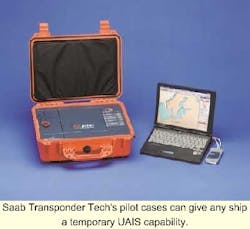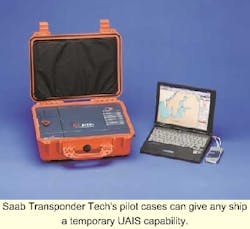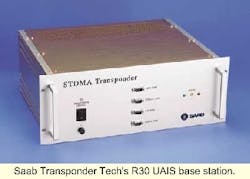VESSEL TRACKING: IMO regulations could improve safety of platform/vessel interaction
A development in the commercial maritime industry designed to improve safety for ship operators could also bring benefits for offshore operators. The introduction of a vessel tracking capability known as UAIS (Universal Automatic Identification System) will begin next July when, under International Maritime Organ isation rules, every new passenger and cargo ship over 300 gross tons will be required to carry a tracking transponder. The require ments will be extended in stages until 2008 by which time virtually every ship over 300 tons will have to be equipped with transponders for UAIS.
Many offshore vessels are unaffected by these regulations but the potential benefits are still expected to make the technology attractive to the industry. This is because each transponder automatically broadcasts the GPS position of the vessel by VHF along with details such as its name, speed and heading.
Similarly equipped vessels can receive these messages which can be displayed in real time on their radar and electronic chart displays. The same information is also available to users within VHF range ashore or on offshore platforms equipped with a UAIS base station that can display the same information on a computer screen.
Also for helicopters
The potential benefits of UAIS for the offshore industry include the ability of rig and platform operators to maintain a detailed watch on shipping. Because the identity of the vessel is revealed it can be contacted directly by radio and given any instructions that may be necessary. The compact dimensions of the UAIS transponder also mean that there is no lower limit to the size of the craft that can be fitted with it. This makes it possible for all standby and rescue craft to be fitted with the system so that the operator can see the status of all of his vessels at a glance. A fully certified version of the transponder is also available for use by helicopters and this too is expected to be of benefit offshore.
UAIS transponders on the majority of ships will be linked to their radar or chart displays. But there is also a version with a minimal keyboard and LCD screen which allows them to be used on smaller, less well-equipped vessels. This facility will make it possible to see and send messages to the four nearest UAIS-equipped vessels in VHF range.
Saab TransponderTech of Sweden is currently the world's only UAIS system manufacturer and the company has been busy responding to orders from ports and national governments eager to introduce some form of vessel tracking technology. The entire Swedish coast is already covered by its system and Saab TransponderTech has recently delivered a base station and 44 vessel units for the Port of Lisbon to form part of a vessel traffic system being installed by Norcontrol. Turkey is next in line and six Saab R30 base stations are due for delivery to Lockheed Martin which will install a system to cover the Turkish Straits. The contract also includes supplying 50 of its unique pilot cases which can give any ship a temporary UAIS capability.
Portable units
The durable waterproof cases are brought on board by the pilot and contain their own UAIS transponder, differential GPS, power supply and a wireless modem. The case is strapped to an outside bridge rail from where the modem communicates with a laptop and electronic chart display used by the pilot inside the bridge. This enables him to monitor his own position and that of all other ships equipped with UAIS transponders within VHF communications range.
UAIS technology is based on a system known as STDMA (Self-organizing Time Division Multiple Access) which transmits messages by VHF in time slots that are automatically allocated to each vessel entering the system and at time intervals appropriate to the situation. There are 2,250 time slots per minute that can each carry 168 bits of data. These provide the opportunity for the system to carry other information and some port authorities are considering it as a medium for supplying differential GPS corrections or data on weather or sea conditions.
Because each transponder is entirely self-contained it does not require any input from a shore base station other than for the provision of these additional services. This means that even ships encountering each other in mid-Atlantic will automatically communicate with each other and Saab TransponderTech now believes that this could be a valuable feature for any operator working far offshore who wants to establish a higher level of safety and vessel control.
For more information contact Holger Ericsson, Saab Transponder Tech. Tel: +46 13 18 80 00, Fax: +46 8 627 49 49, Email: [email protected]


